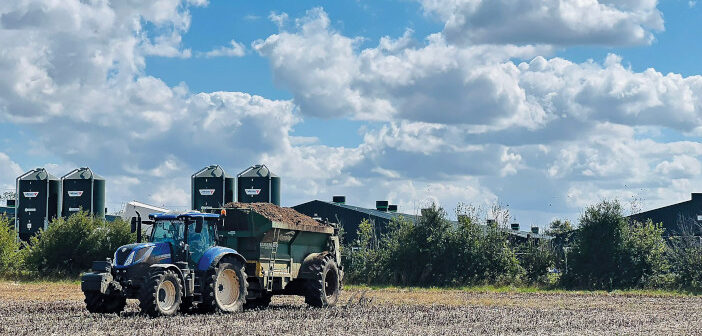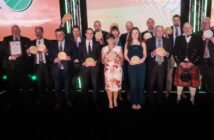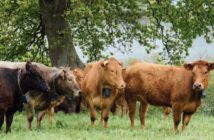The National Arable & Grassland Awards Cereal Grower of the Year has found success by taking control of the cropping regime to find the best solutions on a field-by-field basis.
Across 2,000 acres of arable cropping, Will Oliver has developed a system that offers flexibility to the family business, while also boosting yields and soil health. “I wouldn’t say we’re regeneratively farming,” he said. “We still use the plough and the combi drill when needed, but we’re paying attention to what inputs we apply, boosting organic matter and trying not to move soil unnecessarily.”
Will, named the Cereal Grower of the Year at the 2022 National Arable & Grassland Awards, is the fourth generation to work on the farm, running the business with his father Alf and brother Rory. Having graduated in agriculture and crop management from Harper Adams University in 2011, he went on to study for his BASIS/FACTS qualifications enabling him to take on the farm’s agronomy requirements.
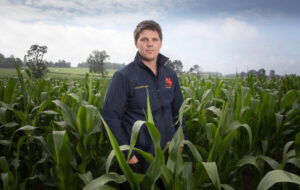
Will Oliver, the National Arable & Grassland Awards Cereal Grower of the Year 2022
“It means we can be fully independent when it comes to the products we apply, and we can gear all of our agronomy to our own aims,” he explained. “It opens the door for us to work with multiple companies and ensure we have the absolute right product, or solution for our circumstances.”
Data is fed into the YAGRO platform, which enables them to compare year-by-year results from each field, showing which crops, varieties and inputs produce the best return on investment. Will says that the programme is easy to use and produces data that is laid out effectively. Used alongside an existing Gatekeeper subscription and the MyJohnDeere and Operations Centre platforms to monitor machinery expenditure and maintenance, he has a full overview of the farm’s performance.
This is backed up by regular nitrogen monitoring with a Yara handheld sensor, tissue sampling to address the needs of the crop and regular trips out with the spade to check rooting and soil health.
As well as benchmarking from field to field, Will is a member of several associations, including the Maize Growers Association, the Association of Independent Crop Consultants and British Institute of Agricultural Consultants. “It’s easy to isolate yourself in this industry, so being part of these organisations means I can get off farm and find out what others are doing to tackle problems, or maximise their yields,” he said.
The farm rotation is focused on wheat and grain maize, with no second wheats, and break crops of winter beans and oilseed rape. Around 200 acres is rented out for potatoes, which Will believes can fit into sustainable agriculture if efforts are made to minimise soil damage ahead of establishment, and to remedy any issues afterwards.
Maize, which can be a similarly tricky crop to grow when taking soil health into account, is sown into a cover crop, shoring up the ground to protect against erosion. To limit pest issues in the following crop, during harvest a Capello header is fitted to the combine, equipped with spinning blades on the underside to destroy residues.
The 500 acres of maize is grown under contract with GLW Feeds, meaning that Will knows exactly what the income of the crop will be.
Flexibility is key
Similarly, to how agronomy is handled on the farm, Will has taken an independent stance on machinery purchases, working with several local dealers as well as buying second-hand tackle.
“We’re not trying to ruffle feathers,” he said. “It’s not necessarily about playing dealerships off against each other, it’s about maximising our access to back-up and spare parts, while also ensuring that we have the correct kit for our situation.”
He added that they have a good relationship with John Deere dealer Farol, T H White for New Holland and Case IH, and others in the area. The farm fleet is headlined by a 380hp Case Magnum RowTrac, with two John Deere 7R machines (290hp and 310hp) and a Fendt 820 providing the rest of the mainline power. Harvesting is handled by a New Holland CR9.90, fitted with a 12m header for cereal crops or the 6m Capello header for maize.
Elsewhere on the farm, there’s another two lower-horsepower John Deere machines, as well as a Massey Ferguson with a front loader. This is backed up by three telehandlers, from Manitou, Kramer and Dieci. Having multiple loaders on site keeps the business efficient and flexible.
“We have poultry units, which need clearing out, then the muck is spread on our fields to boost the organic matter,” Will explained. “But we’ve also got a need for a loader here to handle grain. Trying to do that with fewer machines would lead to unproductive time on the road and greater wear and tear.”
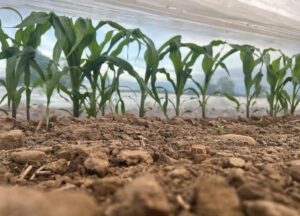
Grain maize is grown under contract and extends the utilisation of the combine
For cultivations, mainline equipment is kept to a minimum. Will says that they are fully equipped to handle eventualities but that the bulk of the work is done with a Vaderstad Carrier and a TopDown, followed by a Horsch Sprinter for direct drilling. For any serious remedial work, a Weaving subsoiler is utilised, while crop care is handled by a trailed John Deere sprayer and an Amazone fertiliser spinner.
Local contractors are called in to manage muckspreading. Will calls the replacement policy opportunistic, paying close attention to what is available on the market, while maintaining the existing fleet to maximise the working life. Keeping capital costs as low as possible helps retain the good margins on crops that lower input costs and the right varieties have afforded.
“The second-hand market has changed a lot in the last few years as more companies have moved online,” he said. “The days of finding a bargain at a poorly attended sale are pretty much gone, but it’s still possible to find suitable, well-looked after equipment that can serve a purpose.”
Boosting the income
Sitting at 2,000 acres, all fairly close to the base, Will explains that the farm is unlikely to grow significantly in size as he looks forward. Instead, the focus has been on adding value to the business through careful diversification and the change of use of some buildings.
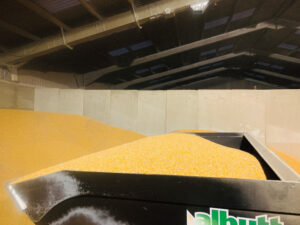
Split between the grain stores and the poultry units, the farm uses three telehandlers
In 2019, the family invested in a poultry unit, adding an additional income source to the business as well as creating a substantial amount of organic manure – which is applied alongside digestate and sludge. The four houses can hold nearly 200,000 broilers in total, with 2,000 tonnes of poultry litter produced in the first year.
Outside of agriculture, the family has invested in commercial and domestic lettings, which are managed in-house and in 2020 purchased the Dandelion Hideaway glamping company. These additional income streams keep the family busy during quieter periods on the farm.
Shifting the focus back on to the farm, Will is keen to maximise the profitability of the ground, moving less productive areas into stewardship schemes to boost environmental credentials while still creating revenue. He has also started to explore carbon credits, using the Farm Carbon Toolkit to measure baselines.
“Everything we’re doing now is about making the business more efficient and more resilient for the future,” he concluded.

